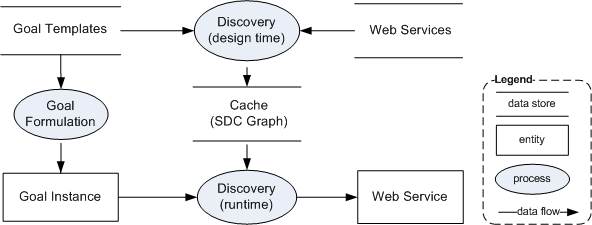This website provides a comprehensive collection of material on the Semantic Discovery Caching technique (short: SDC) that has been developed in course of the PhD research work of Michael Stollberg at the Semantic Technology Institute Innsbruck, completed in 2008.
The PhD thesis is available as a book (available here): Stollberg, M.: Scalable Semantic Web Service Discovery. A semantically enabled SOA Technique for automatically finding Web Services with high Retrieval Accuracy and high Computational Performance. Saarbrücken, Südwestdeutscher Verlag für Hochschulschriften, ISBN 978-3838104515, 2009.
The overall aim is to develop an efficient and scalable technique for automated Web service discovery that ensures a high retrieval accuracy. For this, we have developed a conceptual model for problem-oriented and flexible Web service usage on the basis of goals that formally describe client objectives, and defined a two-phased Web service framework that separates design time and runtime operations. We have specified semantically enabled Web service discovery techniques that expose a high retrieval accuracy, and extended this with a caching-based optimization in order to enhance the computational performance of automated Web service discovery. The figure illustrates the overall approach.

We consider three central entities: Web services that provide some functionality and are accessible over the Web, goal templates as generic descriptions of client objectives that are stored in the system, and goal instances that describe concrete requests by instantiating a goal template with concrete inputs. At design time, the Web services for goal templates are discovered by matchmaking of their formal functional descriptions. The result is stored in the SDC graph, a special knowledge structure which organizes goal templates in a subsumption hierarchy and captures the minimal knowledge on the suitability of the available Web services. At runtime, a client -- either a human or a machine -- formulates the concrete objective to be achieved in terms of a goal instance. As the time critical and expectably most frequent operation in real-world SOA applications, the discovery of suitable Web services for goal instances at runtime is optimized by exploiting the captured knowledge. The following provides information on:
- the PhD Thesis that elaborates the technique in detail
- the Prototype Implementation with licensing and download information
- data on the Evaluation of the SDC technique
- a list of Related Publications.